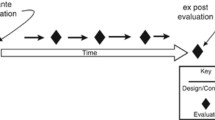Abstract
This paper seeks to improve the understanding of how service-based companies can benefit from developing and delivering service offerings from a standardised core of service modules, which are organised through a service architecture. Research within the field is relatively sparse, and there is scope for an explicit definition of elements related to the development of modular service platforms and architectures. A study of the existing literature, combined with a comprehensive case study in a global engineering consultancy, has created the basis for development and evaluation of the conceptual model for modular service design synthesis presented in this paper. The case study is based on internal documentation and a high level of interview data. Inductive research methods have been used for the analysis. The presented conceptual model defines three suggested dimensions (Market Segmentation, Service Roadmap and Service Architecture Layout) to be included in development of modular service platforms and architectures. Testing indicates a significant standardisation potential for service configuration across service families. Our understanding is that the approach can increase strategic flexibility and adaptability to changes in a quick evolving service market. The empirical part of this paper is exploratory in nature and is limited to one provider of high-end engineering consultancy services. Thus, further research will be needed to verify the aspects of the presented methodology to allow a further generalisation of our findings. Nevertheless, this paper contributes to the emerging literature on service modularity by presenting a specific operational approach for description and utilisation of modular service platforms and architectures.







Similar content being viewed by others
References
Anderson E, Fornell C, Rust R (1997) Customer satisfaction, productivity, and profitability: differences between goods and services. Mark Sci 16(2):129–145
Bask A, Lipponen M, Rajahonka M, Tinnilä M (2010) The concept of modularity: diffusion from manufacturing to service production. J Manuf Technol Manage 21(3):355–375
Birkinshaw J, Gibson C (2004) Building ambidextarity into an organization. MIT Sloan Manage Rev 45(4):47–55
Blok C, Luijkx K, Meijboom B, Schols J (2010) Modular care and service packages for independently living elderly. Int J Oper Prod Manage 30(1):75–97
Carlborg P, Kindström D, Kowalkowski C (2014) The evolution of service innovation research: a critical review and synthesis. Serv Ind J 34(5):373–398
Chae BK (2012) An evolutionary framework for service innovation: insights of complexity theory for service science. Int J Prod Econ 135(2):813–822
Chesbrough H (ed) (2011) Open services innovation: rethinking your business to grow and compete in a new era. Jossey-Bass, San Francisco
Collier D (1981) The measurement and operating benefits of component part commonality. Decis Sci 12(1):85–96
Crawford CH, Bate GP, Cherbakov L, Holley K, Tsocanos C (2005) Toward an on demand service-oriented architecture. IBM Syst J 44(1):81–107
Droege H, Hildebrand D, Forcada MH (2009) Innovation in services: present findings, and future pathways. J Serv Manage 20(2):131–155
Harlou U (ed) (2006) Developing product families based on architectures. Department of Mechanical Engineering, Technical University of Denmark, Lyngby
Hipp C, Grupp H (2005) Innovation in the service sector: the demand for service-specific innovation measurement concepts and typologies. Res Policy 34(4):517–535
Homann U, Rill M, Wimmer A (2004) Flexible value structures in banking. How service-oriented architectures can help achieve the business objectives of the transformation process in banking. Commun ACM 47(5):34–36
Kostopoulos G, Gounaris S, Boukis A (2012) Service blueprinting effectiveness: drivers for success. Manage Serv Qual 22(6):580–591
Lightfoot H, Gebauer H (2011) Exploring the alignment between service strategy and service innovation. J Serv Manage 22(5):664–683
Lin Y, Pekkarinen S, Ma S (2015) Service-dominant logic for managing the logistics-manufacturing interface. Int J Logist Manage 26(1):195–214
Menor LJ, Tatikonda MV, Sampson SE (2002) New service development: areas for exploitation and exploration. J Oper Manage 20(2):135–157
Meyer MH, DeTore A (1999) Product development for services. Acad Manage Perspect 13(3):64–76
Meyer MH, DeTore A (2001) Perspective: creating a platform-based approach for developing new services. J Prod Innov Manage 18(3):188–204
Meyer MH, Lehnerd AP (eds) (1997) The power of product platforms: Building value and cost leadership. The Free Press, New York
Meyer MH, Utterback JM (1993) The product family and the dynamics of core capability. Sloan Manag Rev 34(3):29–47
Mortensen NH, Pedersen R, Fiil Nielsen O, Harlou U, Bøgh MH, Høgh PT, Hvam L (2008) Implementing a product platform in 35 man-days: the visual thinking approach. Int J Mass Cust 2(3/4):240–263
Nijssen EJ, Hillebrand B, Vermeulen PAM, Kemp RGM (2006) Exploring product and service innovation similarities and differences. Int J Res Mark 23(3):241–251
Pekkarinen S, Ulkuniemi P (2008) Modularity in developing business services by platform approach. Int J Logist Manage 19(1):84–103
Perrey R, Lycett M (2003) Service-oriented architecture. In: 2003 Symposium on applications and the internet workshops, pp 116–119
Robertson D, Ulrich K (1998) Planning product platforms. Sloan manag rev 39(4):19–31
Simpson T, Jiao J, Siddique Z, Hölttä-Otto K (2014) Advances in product family and product platform design. Springer Science + Business Media, New York
Sundbo J (1994) Modulization of service production and a thesis of convergence between service and manufacturing organizations. Scand J Manag 10(3):245–266
Tan A, McAloone T, Matzen D (2009) Service-Orientated Strategies for Manufacturing Firms. In: Sakao T, Lindahl M (eds) Introduction to product/service-system design. Springer, London
Tuunanen T, Bask A, Merisalo-Rantanen H (2012) Typology for modular service design: review of litterature. Int J Serv Sci Manage Eng Technol 3(3):99–112
Vargo SL, Lusch RF (2011) It’s all B2B…and beyond: toward a systems perspective of the market. Ind Mark Manage 40(2):181–187
Voss CA, Hsuan J (2009) service architecture and modularity. Decis Sci 40(3):541–569
Acknowledgments
We would like to acknowledge Philip Schur Rørvig for his major contribution to the collection empirical data, which has created the basis for evaluation of the conceptual model presented in this paper.
Author information
Authors and Affiliations
Corresponding author
Rights and permissions
About this article
Cite this article
Løkkegaard, M., Mortensen, N.H. & McAloone, T.C. Towards a framework for modular service design synthesis. Res Eng Design 27, 237–249 (2016). https://doi.org/10.1007/s00163-016-0215-6
Received:
Revised:
Accepted:
Published:
Issue Date:
DOI: https://doi.org/10.1007/s00163-016-0215-6




